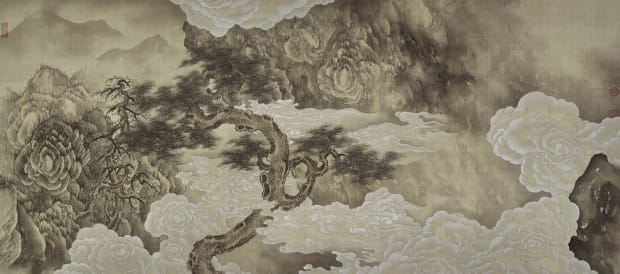Yuan and Aerial View
Yau’s appropriation of satellite image involves his reconsideration of the visual expression of yuan (远) in Chinese painting. Yuan, literally translated to distance or distant, is critical to the visual and conceptual aspects of Chinese landscape painting. It entails depicting an expanse of space at a distance from the viewer, which connotes philosophical concepts such as Tao and infinity. Yuaninspires people to look beyond the visible and finite towards the boundless and infinite, which points to the fundamental pursuit of landscape painters. Guo Xi, in his renowned treatise on Chinese painting Lofty Passages of Forests and Streams, differentiated between three ways of expressing yuan, including high distance (高远), deep distance (深远) and level distance (平远), each corresponding to a type of perspective. High distance refers to looking at the mountaintop from the foot of the mountain; deep distance means viewing one side of a mountain from the other side, and level distance concerns looking at a mountain from the position of another mountain of a similar height.
Looming Sceneries indicates yuan, first and foremost, through masses of cloud painted with a diaphanous quality and a multi-layered texture. Cloud indicates the height of viewers’ standpoint, creating the effect of high distance. For the creation of a number of the works of Looming Sceneries, Yau first crumpled the paper and then rinsed it with water. This washed away the alum powder and broke up the embedded fiber, making it possible for ink splashes and brushstrokes to generate an intricate network of lines (fig. 4). In addition, Yau painted cloud on both the front and back of the thin cicada paper (蝉衣纸). The half-transparent paper allows the paint at the back to be discerned from the front. In this way, the back color that shows through, the materiality of the paper, and the front of the painting conjure a translucent yet densely textured surface. The different shades of white correspond to the way that cloud appears on satellite images. More importantly, this textured surface weaves the cloud, rocks, and grids into a continuum, guiding viewers’ eyes to move smoothly from one spatial unit to another. In the artist’s own words, cloud functions as “the main structural element of his paintings.” It defines shi (势), namely, the direction, the rhythm, and the relationship between compositional elements. As such, Looming Sceneriesreiterates the intricate relationship between discontinuity and continuity exemplified in Platform Travelling.











